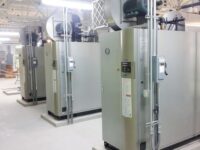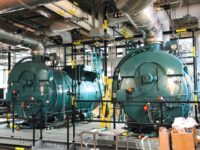Steam boilers play a crucial role in a wide range of industries, from manufacturing and power generation to residential heating. Properly sizing a steam boiler is essential to ensure efficient operation, safety, and cost-effectiveness. In this comprehensive guide, we will delve into the query “How To Size A Steam Boiler?”, exploring key factors and techniques to help you make informed decisions.
Importance of Proper Boiler Sizing
The significance of accurately sizing a steam boiler cannot be overstated. Oversized boilers lead to energy wastage and higher operational costs, while undersized boilers struggle to meet the required heat demand, leading to inefficiency and potential system breakdowns. Proper sizing ensures optimal performance, longer equipment lifespan, and cost savings over the long term.
Understanding the Basics of Steam Boilers
Before diving into sizing methodologies, it’s essential to grasp the fundamentals of steam boilers. These devices generate and distribute steam for various applications, including heating, power, and industrial processes. Steam generation involves heating water until it reaches the boiling point, producing steam that carries thermal energy.
Factors Influencing Boiler Sizing
Several factors influence the size of the steam boiler required for a specific application. These include the desired steam flow rate, pressure, temperature, and the type of fuel used. Additionally, considerations such as altitude, ambient temperature, and system heat losses impact sizing calculations.

Calculating Heat Load Requirements
Accurate sizing begins with calculating the heat load requirements of the system. This involves determining the amount of heat energy needed to maintain the desired temperature within the space or process. Factors like insulation, ventilation, and the climate zone play a role in these calculations.
Types of Steam Boilers for Different Applications
Different applications demand different types of steam boilers. Whether it’s a fire-tube boiler commonly used for residential heating or a water-tube boiler preferred in industrial settings, understanding the distinctions between these types is essential for effective sizing.
Steam Boiler Sizing for Residential Heating
Residential steam boilers require meticulous sizing to provide comfort and efficiency. Factors like the size of the living space, insulation quality, and the number of occupants influence the heat load calculation for these systems.
Industrial Steam Boiler Sizing Techniques
In industrial scenarios, steam boilers serve diverse purposes. Sizing them involves complex considerations, including the nature of the industry, production processes, and peak demand periods. Accurate sizing ensures smooth operations and minimal downtime.
Sizing Steam Boilers for Commercial Buildings
Commercial buildings, such as offices and hospitals, have unique heating requirements. Proper boiler sizing accounts for factors like occupancy levels, ventilation rates, and specific heating zones within the building.

Efficient Sizing for Energy Conservation
Optimal boiler sizing contributes to energy conservation. An appropriately sized boiler operates closer to its peak efficiency, consuming less fuel and reducing greenhouse gas emissions.
Avoiding Common Mistakes in Boiler Sizing
Several pitfalls can lead to improper boiler sizing. Common mistakes include neglecting system dynamics, underestimating heat losses, and overlooking potential expansions. Being aware of these pitfalls helps in making accurate sizing decisions.
The Role of Safety in Boiler Sizing
Safety is paramount when sizing a steam boiler. Oversized boilers can lead to pressure-related accidents, while undersized boilers may struggle to meet safety protocols. Proper sizing ensures safe and reliable operation.
Evaluating Boiler Efficiency Ratings
Boiler efficiency directly impacts operational costs. Manufacturers provide efficiency ratings that help users understand how effectively a boiler converts fuel into heat energy. Considering efficiency aids in making informed choices.
Balancing Boiler Size and System Dynamics
Harmonizing boiler size with the dynamics of the heating system is crucial. Oversized boilers can lead to short-cycling, increasing wear and tear, while undersized boilers fail to meet demand. Achieving the right balance is key.

Future-Proofing Your Boiler Sizing Choice
Considering future growth and changes in demand is vital when sizing a steam boiler. A system that accommodates potential expansions prevents the need for frequent upgrades.
Professional Insights from Boiler Sizing Experts
Seeking advice from boiler sizing experts can provide valuable insights. Professionals consider nuanced factors that might be overlooked, ensuring accurate sizing.
How To Size A Steam Boiler?
A systematic approach to boiler sizing involves gathering data, calculating heat loads, factoring in safety margins, and selecting an appropriate boiler based on manufacturer data.
Incorporating Load Diversity into Sizing
Real-world applications have varying load demands. Incorporating load diversity accounts for fluctuating demands, ensuring the boiler can handle peak requirements.
Sizing Considerations for Steam Distribution
Effective steam distribution is as important as accurate boiler sizing. Factors like pipe diameter, insulation, and pressure regulation impact distribution efficiency.
Environmental Impact of Boiler Over/Under Sizing
Boiler sizing directly affects energy consumption and emissions. Right-sizing boilers contribute to reducing environmental impact.
Retrofitting and Upgrading Existing Boiler Systems
Existing systems can benefit from accurate sizing during upgrades. Retrofitting appropriately sized boilers enhances efficiency and performance.
Conclusion: Optimized Performance through Precise Sizing
Sizing a steam boiler requires a holistic understanding of the application, load requirements, and system dynamics. By meticulously considering these factors, you can ensure your steam boiler operates optimally, delivering efficiency, safety, and long-term cost savings.
FAQs (How To Size A Steam Boiler)
Q1: How does oversizing a steam boiler impact efficiency?
A1: Oversizing a steam boiler can lead to inefficient operation known as “short-cycling.” This occurs when the boiler rapidly heats up, shuts off, and then quickly restarts due to the excessive capacity. Short-cycling not only wastes fuel but also increases wear and tear on the boiler components, reducing its overall lifespan and efficiency.
Q2: What role does insulation play in heat load calculations?
A2: Insulation quality significantly affects heat load calculations. Well-insulated spaces experience lower heat losses, requiring smaller boilers. Proper insulation reduces the load demand, leading to energy savings and a more accurately sized boiler.
Q3: Can I downsize my industrial boiler to save energy costs?
A3: Downgrading an industrial boiler should be approached cautiously. While downsizing may save fuel, it should not compromise operational needs. A professional assessment is necessary to determine if downsizing is viable without affecting production efficiency.
Q4: Is it possible to resize an existing steam boiler in a commercial building?
A4: Resizing an existing steam boiler requires a thorough analysis. Factors such as structural limitations, distribution system compatibility, and updated load requirements must be considered. In some cases, it might be more practical to replace the boiler with a properly sized unit.

